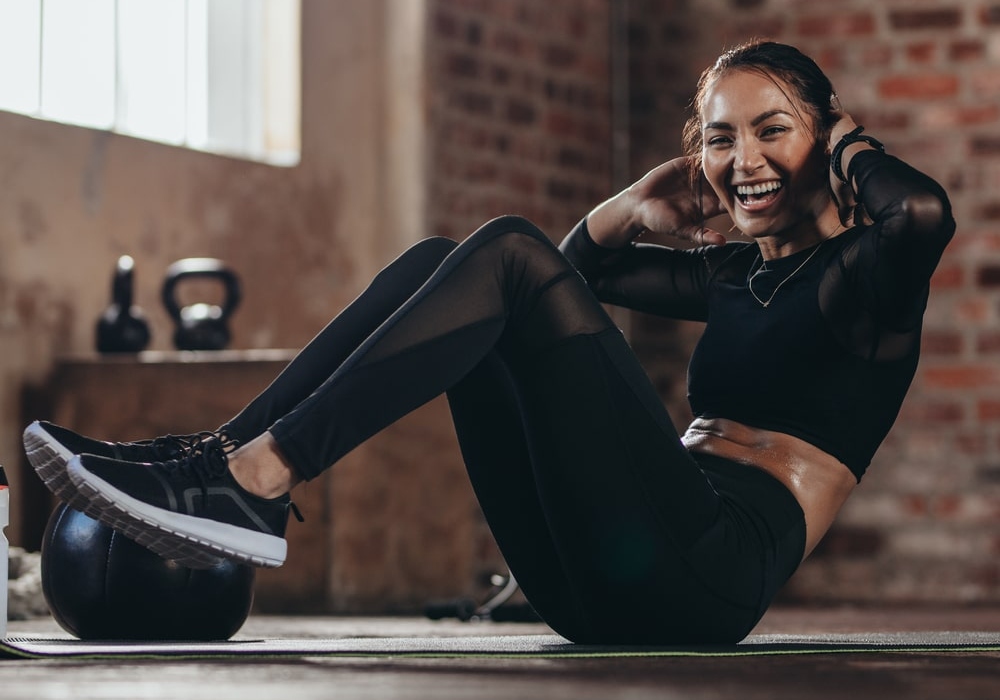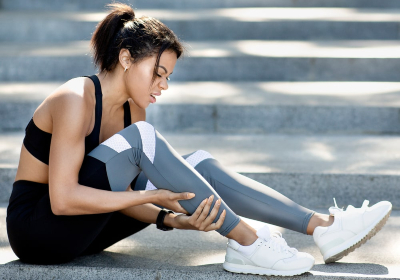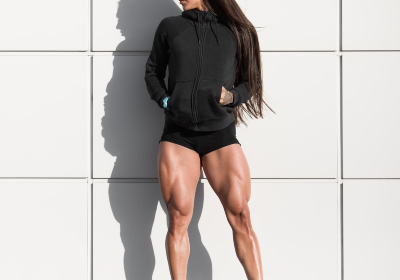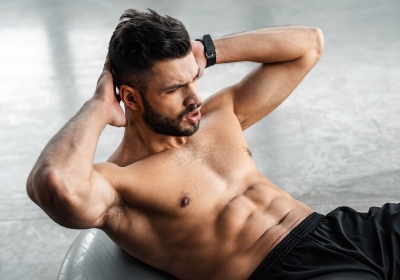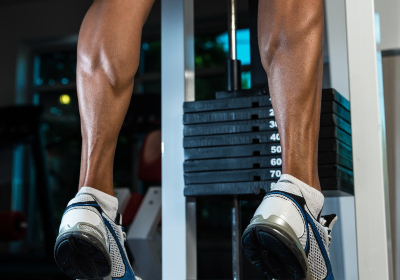VIDEO
Jumping Jacks
- Core
- Gluteus
- Quads
- Hamstrings
- Calves
- Ankles
Level:Beginner
Trainer:Nick Taylor
Equipment:No Equipment
Jumping Jacks
- Core
- Gluteus
- Quads
- Hamstrings
- Calves
- Ankles
Level:Beginner
Trainer:Nick Taylor
Equipment:No Equipment
Stand up with your legs together, slightly bent in knees, and hands resting on thighs. Keeping the knees bent, open the arms and legs out to the sides. Get your arms up to the head while legs wider than shoulders. Then, get your arms and legs back to your sides, returning to the starting position.
save to ...
RECOMMENDED FOR YOU
- Biceps
- Gluteus
- Hamstrings
Duaration: 00:49
save to playlist
ARTICLES
The oblique abdominal muscles are several groups of abdominal muscles on the sides of the core. The external oblique muscle lies on top and the internal oblique muscle - below it. Functional exercises for training them are bending, turning to the sides, and other rotating movements.
However, in order to work your obliques properly, you must remember that most exercises for the oblique muscles involve the other abdominal muscles, the inner transverse muscles, in particular. That's why you need to be able to consciously engage certain areas of the abs during the workout.
The oblique muscles represent the lateral part of the abdominal area. They act as the main rotators of the body. They are represented by two separate muscles, depending on depth and layer:
The outer oblique abdominal muscle forms the superficial layer. It is usually the target of training. It anatomically begins from ribs 5-12.
The internal muscle originates from the lumbosacral fascia, iliac crest, and inguinal ligament. It is attached to the area of the white line, cartilages of ribs 9-12, and pubic crest.
The main task of the oblique abs is to rotate the torso. Although, in addition to the main one, the muscle performs a number of functions:
Tilting of the torso.
Flexion.
Lowering the ribs.
The tension of the anterior abdominal chest wall.
Bilateral contraction.
In general, in order to work your abs properly, it is necessary to follow simple recommendations:
Eat lightly 2-2.5 hours before the exercise. If you train with an empty stomach, you will not work out to your full potential, which means that the workout will be ineffective. An overfilled stomach can also leave negative consequences, such as nausea and severe dizziness.
Warm up your muscles by doing light exercises. Jump, run on the spot or on a machine, do simple tricks like turns, twists, and turns.
Do not overdo it! You don't need to exhaust yourself every day. Try 2-4 times a week - that will be enough for a nice and shapely belly.
Each exercise should stretch your muscles. You should feel how they are tensed. If this is not there, then you are doing something wrong.
Do not eat immediately after the workout. If you feel very hungry, snack on an apple or drink a glass of water. Do not eat after one hour at the earliest.
Read more
Our feet and ankles are one of the most important elements of the locomotor system: without them we can neither stand, walk, run, nor kick someone in the face. Unfortunately, their condition is very often neglected.
Strong and flexible legs provide the basis for stable movement and are of primary importance for performing our daily activities without pain or strain.
The ankle is a block-shaped joint formed by the articular surfaces of the distal ends of the tibia and fibula and the articular surface of the Talus block. Both tibia bones are connected by ligaments and form a kind of fork covering the upper and lateral surfaces of the talus body. The articular sac is reinforced by ligaments.
Many of them connect the bones to each other to provide stability, along with various muscles from the calf to the small tendons that move your toes.
The posterior aspect of the ankle is reinforced by the Achilles tendon, the strongest and most powerful muscle in the human body, which originates at the fusion of the calf and the cambal muscles and is connected to the calcaneus tuberosity.
The ankle joint has to support the weight of the human body and ensure that it is properly distributed when you walk. Therefore, the strength of the ligamentous apparatus, cartilage, and bone tissue is important.
Often people complain of tightness in the muscles of the legs and especially the lower leg. If the small muscles are too weak to keep the foot in the right position, the body responds by increasing tension, elsewhere, in the larger muscles. This leads to tightness in the shin and ankle. Stretching can help for a while, but in the long run, only strengthening the foot is the optimal solution.
Surely everyone who knows about running firsthand knows the importance of strengthening the ligaments of the foot and ankle. Another thing is that sometimes it's hard to spare even 5-10 minutes of training for foot exercises: we get dressed, tie our shoelaces - and run out into the street. That's a pity. After all, good elastic ligaments reduce the risk of foot pain.
Properly fitting shoes is a necessary but not sufficient condition for proper body alignment during running and after training. The ligaments and muscles of the foot can only be strengthened by special exercises.
Read more
One of the most important running muscles is the quadriceps - the large muscle at the front of the thigh. It has been scientifically proven that regular strength training improves workout performance and reduces the risk of injury, as well as strengthens your back, and leg muscles, making your running more productive.
The quads, also known as the quadriceps muscle, is a group of muscles located at the front of the leg above the knee. It is one of the largest and strongest muscles in your body that consists of four heads: fastus medialis (medial wide), vastus intermedius (intermediate wide), vastus lateralis (lateral), and rectus femoris (straight thigh muscle). Almost every action performed by the legs involves two or more heads of the quadriceps. The quadriceps muscle plays an important role at the beginning of the movement (quick start) and during ascent and descent in elevated positions - which is why you may experience painful sensations in this area of the leg after an intense uphill workout.
According to researchers at the University of Delaware, strong quadriceps act as cushioning and can protect the knees and the entire musculature of the hip from common running injuries. Often many runners are injured because they have weak and underdeveloped quadriceps, so it is especially important to strengthen them.
By training and strengthening the quads, you can get the following benefits when running:
Increased speed. Strong quadriceps help you tackle steep hills and climbs more easily and make pushing off the ground more powerful, resulting in increased speed.
Reduced injuries. According to research, poorly developed quadriceps are often associated with many running injuries. For example, a common injury such as the 'runner`s knee' results from weakness in these muscles, which are unable to stabilize the knee joint during the movement.
Increased endurance. Strengthening the quadriceps muscle will make your running more effortless and efficient, which contributes to increased running volume and endurance.
Training
The quadriceps occupy 70% of the muscle mass of the leg, so it is their development that is fundamental in leg training. The main exercise for developing the quadriceps is the squat. But, for beginners, at the first stages of training, it is better to start with leg curls sitting in an exercise machine, leg press, and hyperextensions to strengthen the lower back, to avoid injuries, in order to prepare the base for the heavy squats. It is a good idea to include squats in your training plan after about six months of training.
Read more
Since ancient times, developed muscles have been one of the hallmarks of a harmoniously developed, athletic body. There is no such thing as 'abs' in anatomy. This is a conditional abdominal muscle. There are four of them:
rectus;
internal oblique;
external oblique and transversus.
The rectus abdominis muscle is the largest in area. It’s a popular fallacy that there is a 'lower' and 'upper' press, but the rectus muscle does not have such a division. The notorious 'six-pack' stands out because of the tendon bridges on the rectus abdominis muscle. The muscle bundles of the external abdominal muscle begin from the lower eight ribs and extend radially downward. The transverse muscle is located deeper than the other abdominal muscles. In this case, the tendon extension in the upper two-thirds passes behind the rectus muscle, and in the lower third - in front. Partly because of this, the lower abs are less workable than the upper ones. The abdominal muscles are referred to as the core muscles, the muscle complex responsible for stabilizing the spine, pelvis, and hips. Each of the abdominal muscles is responsible for its own functions. One of the most common fallacies in abdominal training is that the more reps we do in a set, the stronger and bigger the abs will be. In fact, the muscles of the abs are no different in terms of training from the biceps. To increase the biceps, you will do one hundred reps per set. However, you will reduce the number of sets and reps, but increase the load. By increasing the number of repetitions in the set, you will develop strength endurance, but the muscle will not get thicker from this. It is much more effective to increase the load, do sets with weights and reduce the number of repetitions in the set. Three factors affect the appearance of your abs: posture, body fat percentage, and muscle development.
Posture.If a person pumps muscles but slouches, and he has excess fat, then the abs will not be visible. If a person does not pump the abs, but he has a good posture and a small percentage of body fat, then his belly will look flatter. That is why it makes no sense to start with the question of how to properly pump the abs. You need to start by working on your posture. The good news is that your core muscles are also responsible for correct posture. And they are usually used in workouts with an emphasis on the abs.
Fat percentage.Measuring body composition on an analyzer scale will show the percentage of body fat, which explains why the abs are invisible. If the fat is more than 15-20%, then it’s hard to see your six-pack. At 15% or less, the abs begin to be seen. 8% is abs athletes have. But do not try to completely get rid of fat for beautiful abs. Fat is necessary for the proper functioning of the endocrine system and other processes in the body. To achieve tangible results, it is important to monitor the factors that affect the percentage of body fat like food, sleep, stress levels, and the amount of daily physical activity.
Muscle development.You mustn’t focus only on abs exercises, you need to develop the body complexly and do a variety of activities. Strength training will strengthen your muscles, burn calories and build endurance with interval training. Recovery activities help with posture, flexibility, and muscle balance. The optimal training program can be selected after fitness testing, which takes into account how a person moves, what restrictions he has.
Read more
Building up the calf muscles and make your legs beautiful is quite difficult, but possible. It is difficult because the legs are used to constant strain (usually people walk a lot). And it becomes possible thanks to the proven exercises, which can effectively train this group of muscles. In this article, we will take a detailed look at the anatomy of calves, their functions, and exercises that you can do to help make them stronger.
The calf muscle is the most superficially located muscle of the lower leg that crosses two joints: the knee and ankle. Like the biceps of the shoulder, it consists of two heads: medial (located closer to the inside of the tibia) and lateral (located closer to the outside of the tibia). It is interesting to note, that about 5.5% of Japanese and about 3% of people of other nationalities may have the 3rd head of the calf muscle, which attaches from above between the fixation sites of the medial and lateral heads, and may connect from below either to the lateral head (less often) or to the medial head (more often).
The primary function of the calf muscle is to lift the supporting leg, which causes a person to move forward along with flexion of the knee and ankle joints. Running causes a lot of stress on the calf muscles that is why many sprinters face the problem of calf pain.
There are also other functions of the calf muscle.
The calf muscle is involved in the plantar flexion of the foot, which occurs during walking, running, or cycling;
It is also activated during flexion of the leg at the knee joint;
It participates in the supination of the foot (its outward rotation);
The calf muscle takes part in the stabilization of the knee and ankle joints and also helps to keep the balance in the upright position of the body.
There are many reasons that can cause calf pain. And to prevent this unpleasant situation, the following rules should be followed:
running at a comfortable pace;
warming up before running and stretching after training;
comfortable shoes suitable for running;
a smooth transition from running to stopping after a step;
drinking plenty of water after the workout;
a warm shower/bath and a massage to relax the muscles.
The reasons why the calf muscles are not as developed as you would like them to be could be the following:
too much training aimed at working out this muscle group;
not enough exercise;
the wrong set of exercises.
It is necessary to choose the right exercises for the calf muscles. It must be noted that the surface muscle is worked out in a standing position, and the cambalic muscle in a sitting position. To train as effectively as possible, it is necessary to load both muscles.
And the last, but not the least advice: do not try to achieve serious results by performing endless repetitions, such as deadlifts. The main secret of how to pump up the calf muscles is heavy training with weights. It is recommended to train your calves no more than 2 times a week.
Read more
SAVE TO ...

